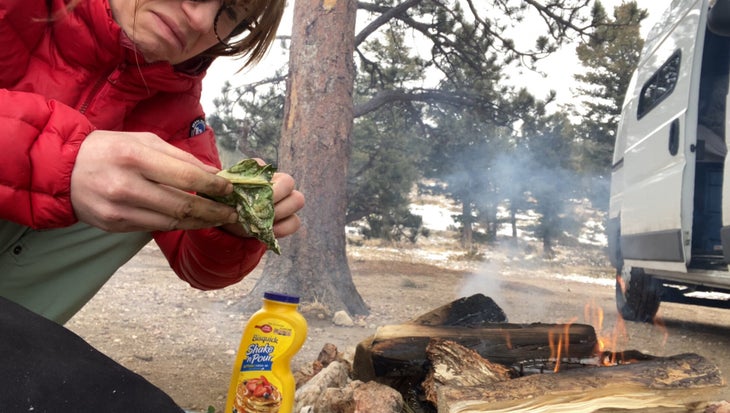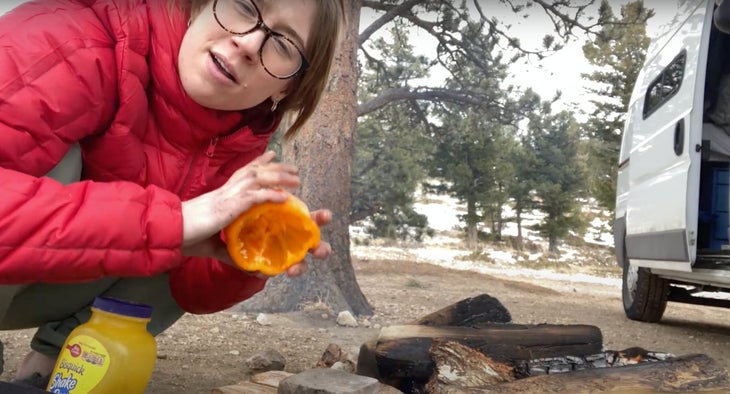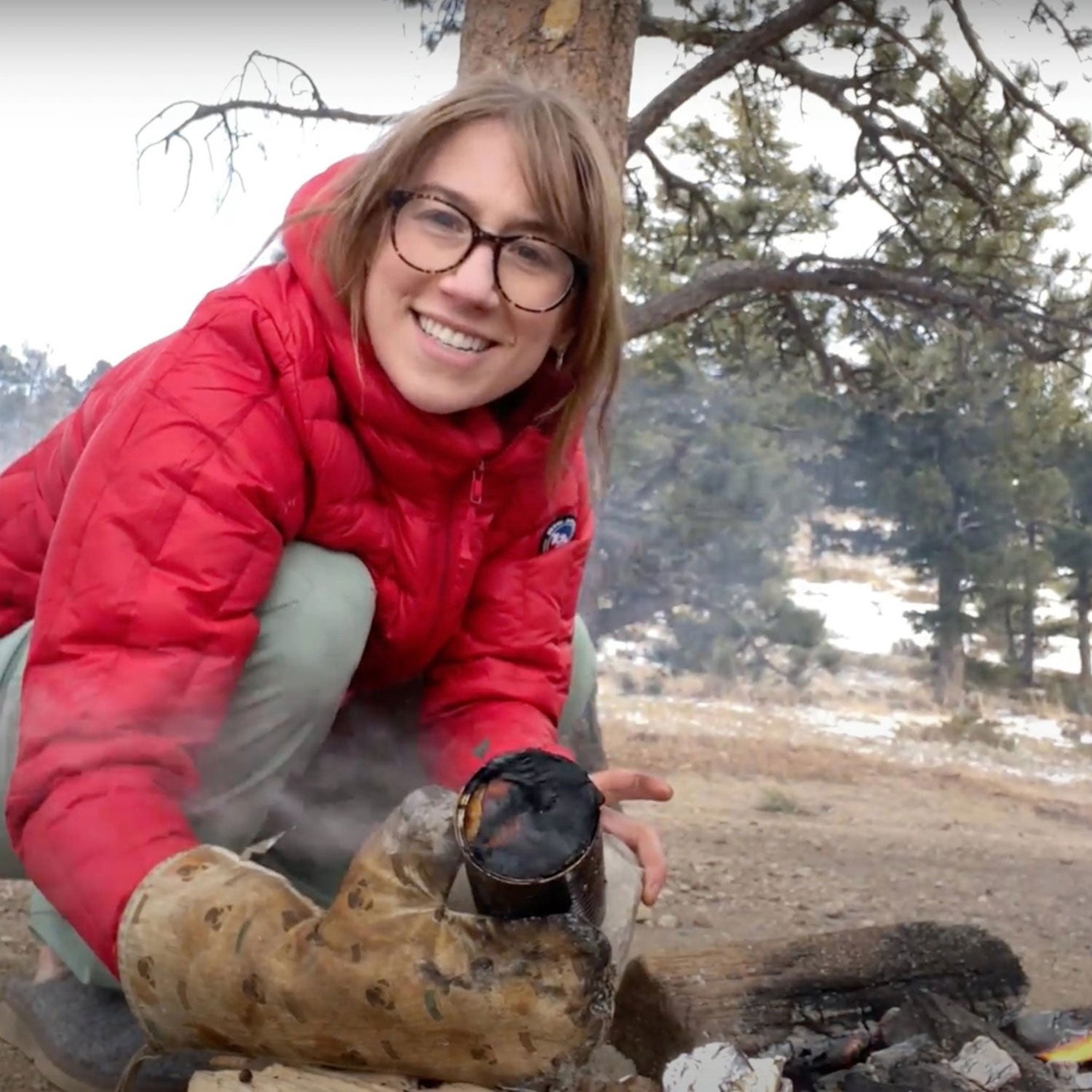The internet is full of dubious advice. Most of the time I do a pretty good job of ignoring it, but when I stumbled upon a string of bizarre camp cooking tips, I became fascinated. Why are people eating leaves? Why are they filling empty beer cans with popcorn kernels? These hacks couldn’t possibly work—could they? After watching a number of viral videos, I decided to try a few of the more popular camp cooking hacks for myself.
I started the day with a bag of groceries, a bundle of firewood, and an inordinate amount of hope. I ended it with two burned fingers, one burned tongue, and a lump of charcoal that had once been a pie crust. Here’s what worked—and what absolutely didn’t.
Cook an Egg on the Bottom of a Beer Can
Rating: 2/10
On the internet, this trick looked pretty sleek: Cut a door into the side of an empty can, turn it upside down, build a fire inside with sticks and leaves, and cook an egg in the divot on the bottom. In real life, it didn’t work so well. For one thing, the tiny basin in the bottom of a beer can is not, in fact, big enough to hold an average egg. Despite using the utmost care in applying my egg to the back of the can, about half of it dribbled off the side and into my fire, putting it out. Restarting the fire was not easy. A beer can—even one with a window cut into the side—does not permit sufficient oxygen flow to keep a fire going on its own. To preserve the flames, I had to spend a lot of time poking at it with a stick. Eight times out of ten, this poking caused my top-heavy cook system to topple over. And two times out of ten, I burned myself trying to set it upright again.
But burning the prints off your fingers isn’t the only risk you’ll endure while attempting this hack. Many beer cans are lined with an epoxy coating and then covered with artificial inks and dyes. Setting these on fire—and then eating an egg you’ve thoroughly smoked in the toxins—probably isn’t the best for your health.

Cook Bacon on a Rock
Rating: 5/10
The internet seems fond of doing things in the worst way possible. For this trick, you first need to find a perfectly flat, smooth, clean rock on which to cook your breakfast. That’s pretty difficult to achieve in practice, especially once you learn that river rocks are off-limits (water trapped in the fissures can expand when heated, causing the rock to explode). After a half-hour of searching, I found a suitable rock, brushed it off the best I could, set it over my coals, and laid three strips of bacon over top. The bacon did indeed cook to a reasonable consistency, though I spent the rest of the morning picking bits of dirt and sand out of my teeth. In theory, it’s a cool bit of bushcraft; in practice, whatever time you gain by lightening your pack, you’ll lose that and more to searching for rocks. My recommendation: If you’re going to carry bacon, you might as well carry a pan too.

Batter a Leaf, Cook It on a Rock, and Eat It
Rating: 3/10
I don’t know why anyone would want to cover a leaf in Bisquick and eat it, but it seems that’s what the Internet is up to these days. So, I tried it. Because trees have no leaves in Colorado in early March—and I personally am loath to eat pine needles for breakfast—I used a piece of chard. I liberally covered the leaf in batter, then cooked each side on a hot rock for about three minutes. The result was a sort of crisp, beige chip, which looked nasty but actually tasted quite good. Still, I will not be doing this again any time soon; the next time I find myself with nothing but Bisquick and a hot rock, I’m just making pancakes.

Cook Scrambled Eggs in a Bell Pepper
Rating: 9/10
Finally: Tremendous success. The walls and top of the bell pepper provided enough insulation to keep my eggs from burning or drying out. The result was a fluffy, two-egg scramble—no kitchenware required.
I started by whisking two eggs inside a hollowed-out pepper before replacing the pepper’s top to serve as a lid. I then placed the bundle in a nest of hot coals and set a large coal atop the lid to ensure even heating. By the end, the pepper itself was carbonized, having selflessly given its life to my pursuit of a mediocre camp quiche. But the eggs were perfectly adequate.
If you were determined to eat your pepper, you could theoretically wrap it in aluminum foil to protect it from charring. However, that makes it tough to peek under the lid to periodically check for doneness.

Bake an Apple Pie in a Tin Can
Rating: 5/10
This was truly a learning experience. If I were to do this again—which I most certainly won’t—I would start with a larger can. Second, I’d warm up my pie crust before shaping it. My great-grandmother may roll over in her grave at that suggestion (traditionally, you want your crust as cold as possible before baking), but warming the dough is really the only way to get it malleable enough to squish into a can without tearing to bits. I used a store-bought crust and a premade apple pie filling, because I am a heathen. If you are the more enterprising sort, you are welcome to make your own.
I let my pie cook for about 15 minutes buried in coals. Judging by the unrecognizable black mass I ended up with, I’d say this was too many minutes. Ten would probably be better, depending on the temperature of your coals. However, despite my best efforts, I still ended up with a pie that had a mostly edible interior, and the crust was clearly cooked all the way through.
Overall, I would say this sort of worked. If you’re desperate for campfire pie, though, you’re better off keeping it simple: Make an apple turnover, wrap it in tinfoil, and bake it in coals like a normal person.

Make Popcorn in a Beer Can
Rating: 2/10
If you’ve decided to carry beer into the backcountry, manifesting an empty can is very easy. So is stuffing kernels through the tiny hole in your vacated drinking vessel. However, as I watched the can’s label melt and disfigure in the flames, I couldn’t help but wonder about my future cancer risk. And once the corn was finally popped, I discovered an even more terrible problem: Popped corn is too big to fit through the exit. To access my hard-earned snack, I had to split the can open with my giant survival knife.
The good news is that I finally have a use case for carrying around a 14-ounce knife. The bad news is that I don’t often trust myself to use it to cut metal after consuming a beer on an empty stomach. And even when I did (somehow managing to keep all 10 fingers attached), I discovered my popcorn badly burned. .

